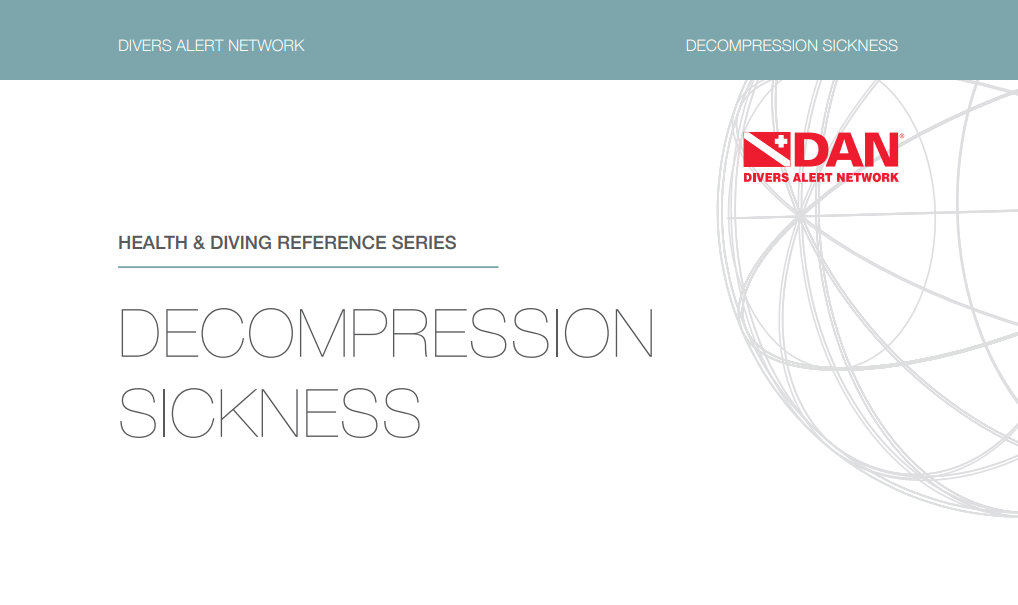What You Need to Know About the DAN Decompression Sickness Health and Reference book is it is the most reliable source of information about DCS. Download the booklet by clicking on the picture below.

Decompression sickness (DCS) is a serious but preventable risk in diving. Every dive plan should include strategies to minimize its occurrence. This booklet offers up-to-date insights into the causes and mechanisms of DCS, its common symptoms, recommended treatment, and essential prevention practices.

This 40-page book aims to help prevent decompression sickness (DCS) from affecting as many scuba divers as possible. DAN explains in clear terms how a diver’s body responds to changes in pressure, tissue tension, and gas exchange at depth. As pressure increases, inert gases like nitrogen dissolve into body tissues. The deeper the dive, the faster the rate of gas absorption. Upon ascent, the surrounding pressure decreases, and these dissolved gases begin to leave the tissues. A slow, controlled ascent allows for safe off-gassing, while a rapid ascent increases the risk of DCS. Gas exchange is driven by pressure gradients, with the lungs serving as the primary site for eliminating inert gases. Saturation is reached when tissue gas levels match the ambient pressure, but achieving full saturation requires extended time at depth.
The book also introduces the concept of tissue compartments, a cornerstone of decompression theory. These compartments are mathematical models that estimate how different body tissues absorb and eliminate gases at different rates. In each half-time period, a tissue takes up or releases half the difference in gas pressure. Supersaturation occurs during ascent and, if excessive, can lead to gas bubble formation and DCS. Dive tables and dive computers rely on these models to determine safe ascent limits, but actual decompression risk is influenced by real-world factors such as temperature, exertion, and individual physiology. For this reason, conservative diving practices are essential.
DAN also reminds divers that, despite their sophistication, dive computers have real-time limitations based on the data they can process. Chapter 2 outlines key guidelines for using your dive computer effectively and highlights the role of dehydration, a major contributor to DCS risk that no current dive computer can measure directly.
Dehydration is an internal state that requires monitoring factors like fluid balance, blood concentration, and core body temperature—none of which dive computers can detect. Although some smartwatches are exploring hydration tracking through skin sensors, this technology has yet to be incorporated into dive computers. Additionally, factors such as breathing dry gas and diving in cold environments can accelerate fluid loss, yet these too are not accounted for in most dive algorithms.
Still, some advanced dive computers offer helpful health tracking features. For example, the Garmin Descent Mk2i can monitor heart rate and skin temperature (with a compatible chest strap), provide hydration reminders between dives, and estimate workload and stress. These tools, while indirect, can support better self-awareness and safer diving decisions.
DAN also shares practical advice for using your dive computer wisely. Relying on your device isn’t inherently unsafe, as long as you recognize its limitations. Pay attention to alerts, use it as more than a logbook, and most importantly, be ready to say, “Let’s stop the dive” if something doesn’t feel right or your computer malfunctions. Your awareness and training are always your best safety tools.
In addition to foundational dive science and computer use, this book offers reliable insight into more advanced topics. Chapter 3 helps divers and dive professionals recognize the signs and symptoms of DCS, distinguish it from other conditions through differential diagnosis, and respond quickly. Chapter 4 covers vital steps in treating DCS, including on-the-scene first aid, subsequent medical evaluation, hyperbaric oxygen therapy, in-water recompression, and a list of essential emergency resources. Finally, Chapter 5 explores the factors that contribute to DCS, such as workload, thermal stress, air travel after diving, fitness to dive, hydration, gas mixtures, carbon dioxide levels, PFO (Patent Foramen Ovale), and other physiological and environmental influences.
Whether you’re a new diver trying to understand your body underwater or an experienced one seeking to refine your safety practices, this book delivers the practical, science-backed knowledge you need to dive smarter and safer.

